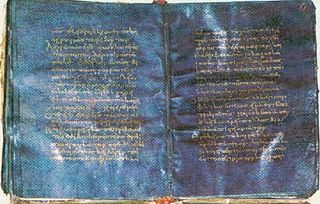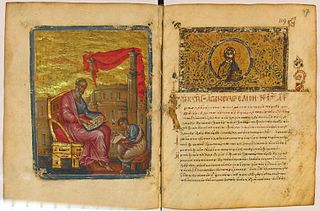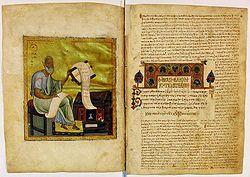
Minuscule 565, ε 93 (Soden), also known as the Empress Theodora's Codex, is a Greek minuscule manuscript of the New Testament, written on purple parchment, dated palaeographically to the 9th century. It was labelled by Scrivener as 473. The manuscript is lacunose. It has marginalia.
Uncial 0122, α 1030 (Soden), is a Greek uncial manuscript of the New Testament. Palaeographically it has been assigned to the 9th-century. Hort designated it by Od.
Minuscule 273, ε 370 (Soden), is a Greek minuscule manuscript of the New Testament, on vellum, but partly on cotton paper. Palaeographically it has been assigned to the 13th century. The manuscript has complex contents. It has marginalia.
Minuscule 275, ε 292 (Soden), is a Greek minuscule manuscript of the New Testament, on parchment. Paleographically it has been assigned to the 12th century. It has marginalia.
Minuscule 283, ε 373 (Soden), is a Greek minuscule manuscript of the New Testament, on parchment. Palaeographically it has been assigned to the 13th century. It has marginalia.
Minuscule 282, ε 280 (Soden), is a Greek minuscule manuscript of the New Testament, on parchment. It is dated by a colophon to the year 1176. It has full marginalia.

Minuscule 330, δ 259 (Soden), is a Greek minuscule manuscript of the New Testament, on parchment. Palaeographically it has been assigned to the 12th century. It has marginalia. The Greek text of the codex is a representative of the Byzantine text-type.

Minuscule 568, ε 189, is a Greek minuscule manuscript of the New Testament, on parchment. Palaeographically it has been assigned to the 10th century.
Minuscule 566, ε 93 (Soden), also known as the Empress Theodora's Codex. It is a Greek minuscule manuscript of the New Testament, on parchment, dated palaeographically to the 9th century.
Minuscule 570, ε 1220, is a Greek minuscule manuscript of the New Testament, on parchment. Palaeographically it has been assigned to the 12th century. The manuscript is lacunose. It was labelled by Scrivener as 479.
Minuscule 572, ε 1221, is a Greek minuscule manuscript of the New Testament, on parchment. Palaeographically it has been assigned to the year 12th century. It was labeled by Scrivener as 480. The manuscript has not complex contents.
Minuscule 571, ε 1294, is a Greek minuscule manuscript of the New Testament, on parchment. Palaeographically it has been assigned to the year 12th century. It was labeled by Scrivener as 474. The manuscript is lacunose.
Minuscule 574, ε 1295, is a Greek minuscule manuscript of the New Testament, on parchment. Palaeographically it has been assigned to the 13th century. The manuscript is lacunose.

Minuscule 575, ε 352, is a Greek minuscule manuscript of the New Testament, on parchment. Palaeographically it has been assigned to the 15th century. It was labeled by Scrivener as 477. The manuscript has complex contents.
Lectionary 252, designated by siglum ℓ252 is a Greek manuscript of the New Testament, on parchment. Palaeographically it has been assigned to the 11th century. Frederick Henry Ambrose Scrivener labelled it as 195evl.
Lectionary 253, designated by siglum ℓ253 is a Greek manuscript of the New Testament, on parchment. It is dated by a colophon to the year 1020. Scrivener labelled it as 196evl.
Lectionary 255, designated by siglum ℓ255 is a Greek–Arabic manuscript of the New Testament, on parchment. Palaeographically it has been assigned to the 11th century.
Lectionary 258, designated by siglum ℓ258 is a Greek manuscript of the New Testament, on parchment. Palaeographically it has been assigned to the 13th century. Scrivener labelled it as 197evl. Only four leaves of the manuscript have survived.
Minuscule 729, Θε323, is a Greek minuscule manuscript of the New Testament written on parchment. Palaeographically it has been assigned to the 13th century. The manuscript has complex contents. Scrivener labelled it as 747e.
Uncial 0321, ε 2 (Soden), is a Greek uncial manuscript of the New Testament, dated paleographically to the 5th-century. The manuscript has survived in very fragmentary condition.




